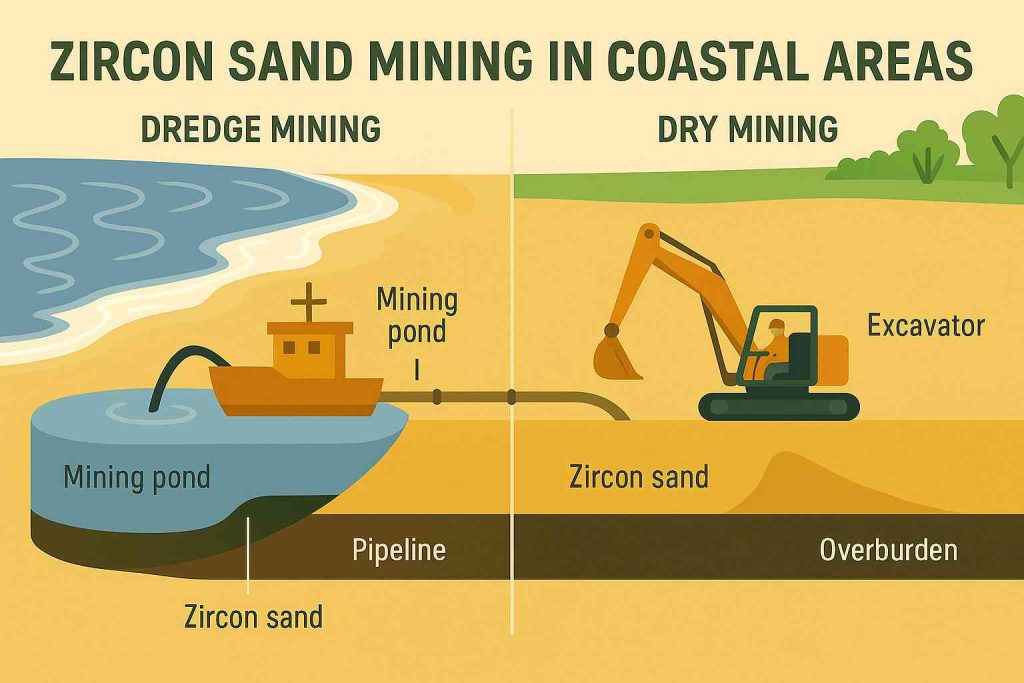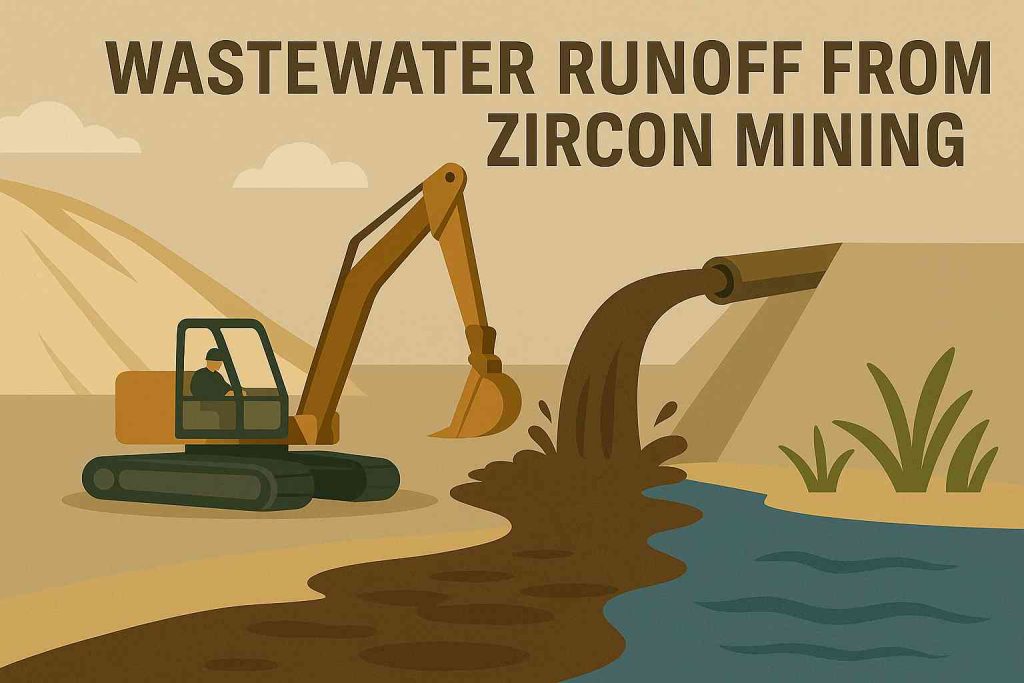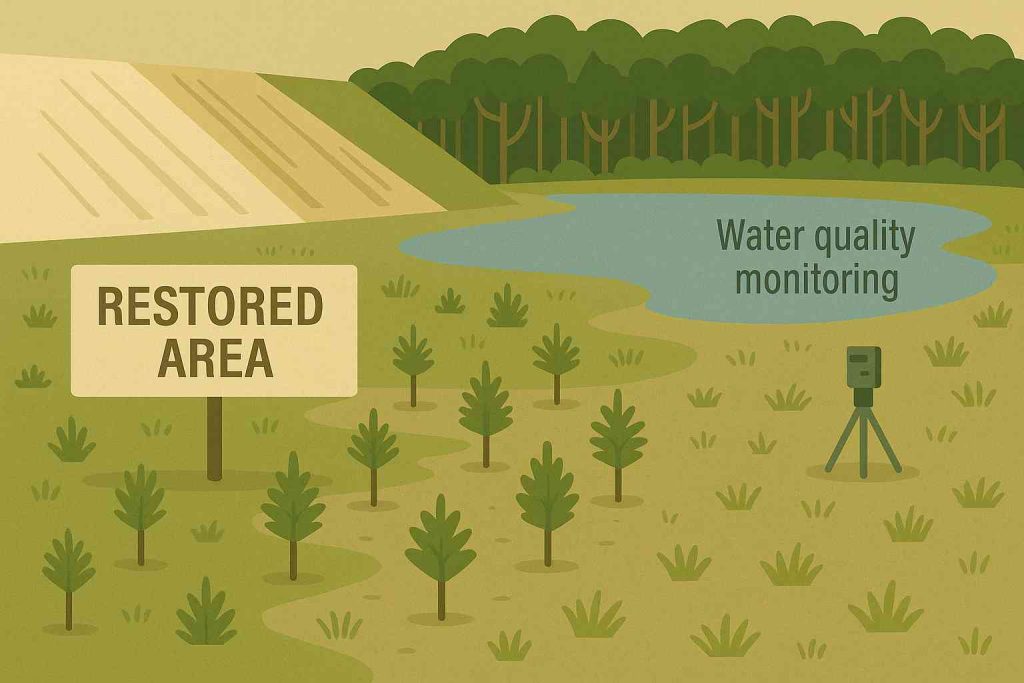Zircon sand mining plays a central role in supply chains for ceramics, casting, and precision industries. However, for procurement professionals and environmental teams, there’s a growing concern: what long-term risks come with sourcing from zircon sand mining operations? The issue goes far beyond raw material extraction. Environmental damage from zircon sand mining can ripple through ecosystems, local communities, and global procurement. This article outlines where those problems start—and how to make informed, low-risk sourcing decisions. You’ll find practical insights into how zircon sand mining affects land, water, air, and people, with real-world examples and B2B implications. Our goal is to help buyers and managers assess environmental trade-offs clearly and credibly.
What is zircon sand and where is it mined?
Zircon sand is a mineral compound mainly composed of zirconium silicate. It’s extracted through zircon sand mining processes and used in ceramics, foundry casting, and even electronics. What makes it valuable is its high thermal resistance and chemical stability. The largest zircon sand mining operations are located in Australia, South Africa, and Mozambique. These regions provide consistent quality and high-yield ore bodies.
Let’s break this down. Zircon sand mining methods vary depending on terrain and deposit location. In coastal zones, wet dredging is common. Inland, dry excavation dominates. Each technique used in zircon sand mining carries unique environmental implications.
Two common mining approaches include:
- Wet dredging, which removes sediment from water-rich deposits.
- Dry mining, used in arid regions where zircon layers are exposed near the surface.
Both practices involve clearing vegetation, removing topsoil, and generating fine-grained waste. Over time, large-scale zircon sand mining can degrade landscapes and displace natural systems.
| Country | Mining Method | Major Use | Notable Environmental Risk |
|---|---|---|---|
| Australia | Dry mining | Ceramics, refractory | Soil erosion, dust emissions |
| South Africa | Dredging | Foundry casting, glazes | Waterway disruption |
| Mozambique | Mixed methods | Tile production, pigments | Forest loss, community impact |

A visual overview of zircon sand extraction using both dredging and dry mining in a coastal area
How does zircon sand mining affect land stability?
Zircon sand mining removes vegetation and topsoil from targeted areas. Once the protective ground cover disappears, rain and wind erosion increase. The result? Exposed surfaces and lands vulnerable to degradation.
Here’s why that matters. In regions where zircon sand mining is aggressive, fertile land can become unstable within months. Wind carries fine dust away. Rain flushes loose sediment downstream. And as operations expand, this impact grows geometrically.
Another serious concern in zircon sand mining is ground subsidence. Underground voids left unfilled after ore removal can collapse, damaging infrastructure or farmland above. Over time, unregulated mining leads to fractured terrain that’s difficult to restore.
| Effect on Land | Description |
|---|---|
| Soil erosion | Topsoil loss from rain or wind |
| Vegetation decline | Destruction of trees and grasses |
| Land subsidence | Ground collapse after mining |
| Surface instability | Increased risk of landslides or slope failure |
What are the effects on local water systems?
Zircon sand mining requires water—lots of it. Dredging operations pull in river water to separate zircon from lighter materials. Processing plants use additional water for washing and refining. This leads to both depletion and pollution.
Here’s the issue. In areas with limited water supply, zircon sand mining strains agricultural irrigation and household needs. At the same time, waste ponds and tailings contain toxic sediments. If these leak or overflow, local aquifers may become unsafe.
Heavy metals, such as thorium or uranium traces, can leach from zircon sand. Without proper containment, they spread through water bodies. Fisheries and crops are put at risk. Even human drinking water is threatened when runoff infiltrates groundwater.
| Water Impact | Risk Level | Notes |
|---|---|---|
| Excess water withdrawal | High | Competes with agriculture |
| Contamination from tailings | Medium | Requires proper lining and containment |
| Aquatic habitat damage | High | Turbidity and pH changes kill local fauna |

This image shows how improper waste handling can lead to contamination of nearby water bodies
How does mining zircon sand impact air quality?
Zircon sand mining also contributes to airborne emissions. During excavation and processing, fine dust particles are released. These contain silica and sometimes radioactive residues from the zircon itself.
Let’s be clear. Workers exposed to unfiltered air may face respiratory issues. Nearby towns also report increased asthma, chronic coughing, and visibility problems from dust haze.
Mining vehicles and machinery burn diesel. This adds nitrogen oxides and particulate matter to the air. Even with wet suppression techniques, emissions persist if controls aren’t rigorously applied.
| Air Pollutant | Source of Emission | Health Impact |
|---|---|---|
| Particulate matter | Excavation and transport | Lung irritation, asthma |
| Radioactive dust | Ore crushing and milling | Long-term cancer risk |
| Exhaust gases | Mining trucks and machinery | CO2 emissions, smog |
What waste is produced during zircon extraction?
Zircon sand mining produces significant waste streams. The most visible form is tailings—fine sand left after zircon is extracted. These tailings may include low-grade minerals, clays, and hazardous particles.
And here’s the risk. Tailings need proper storage in lined ponds or impoundments. When these systems fail, toxic slurry can move into surrounding land or rivers.
In addition to tailings, zircon sand mining generates industrial waste such as:
- Used oil and lubricants from machinery
- Chemical containers
- Maintenance residues like filters and sealants
Without formal waste plans, this material accumulates. It seeps into soil, affecting nearby farms and homes.
| Waste Type | Description | Handling Challenge |
|---|---|---|
| Tailings | Fine particles with possible toxins | Require lined, monitored ponds |
| Sludge/Effluent | Water with chemical residues | Needs filtration/treatment |
| Solid industrial | Lubricants, filters, worn parts | Disposal infrastructure |
How are nearby ecosystems affected?
Zircon sand mining destroys native habitats. Clearing forests or mangroves displaces species that can’t relocate. Once these connections are broken, entire food chains suffer.
Let’s look deeper. Aquatic species are vulnerable too. Sediment from zircon sand mining enters rivers, raising turbidity and lowering oxygen. Amphibians, shellfish, and native fish populations decline.
In some cases, protected species lose breeding areas. Migratory birds, for example, skip disturbed wetlands. Insects that pollinate local crops also decline when native plants disappear.
| Ecosystem Effect | Specific Outcome |
|---|---|
| Habitat fragmentation | Isolates animal populations |
| Loss of keystone species | Cascading food web disruption |
| Water pollution | Reduces aquatic biodiversity |
| Forest degradation | Impacts carbon storage and erosion |
What are the social consequences for communities?
Zircon sand mining doesn’t just damage nature—it reshapes societies. In rural areas, people may be displaced or pushed off farmland. Even when relocation packages are offered, they’re often delayed or inadequate.
And that’s not all. Noise and dust affect health. People report more respiratory illness, especially children and elderly. Jobs often go to outsiders, leaving local labor markets unchanged.
Cultural harm is common too. Sacred lands or ancestral forests are destroyed. Once gone, they can’t be rebuilt.
| Social Impact | Description |
|---|---|
| Land disputes | Legal battles, forced evictions |
| Health hazards | Increased respiratory and waterborne disease |
| Economic imbalance | Unequal benefit distribution |
| Cultural loss | Destruction of sacred or heritage sites |
How is environmental damage assessed and monitored?
Zircon sand mining operations must usually pass Environmental Impact Assessments (EIAs) before receiving permits. These reviews predict how mining will affect land, air, and water.
Here’s the problem. Some zircon sand mining projects submit weak or outdated EIAs. After approval, enforcement is often inconsistent. Site visits are rare, and penalties are light.
New technologies help. Satellite images now track land clearing in near real time. Water testing, dust sampling, and community interviews provide data to watchdog groups.
| Monitoring Tool | Purpose |
|---|---|
| EIAs | Initial assessment of project impact |
| Water and air sampling | Ongoing pollution checks |
| Satellite imagery | Detecting land disturbance over time |
| Public reporting | Collecting feedback from affected groups |
Are there regulations governing zircon mining?
Yes, but they vary. Some regions enforce strict zircon sand mining regulations; others don’t. This inconsistency creates sourcing risk.
Here’s the takeaway. Buyers sourcing zircon sand mining output from poorly regulated zones face uncertainty. If a mine shuts down for violations, deliveries may halt.
Regulations typically cover:
- Land restoration
- Water use limits
- Tailings disposal
- Worker safety
Some buyers now ask for third-party certifications before signing supply contracts. This helps reduce reputational risk.
| Regulatory Factor | Scope of Regulation |
|---|---|
| Water withdrawal limits | Prevent overuse in dry regions |
| Tailings storage rules | Avoid contamination and overflow |
| Emissions controls | Limit dust and gas release |
| Restoration requirements | Mandate post-mining land repair |
What can companies do to reduce harm?
Zircon sand mining operators can adopt smart strategies that protect ecosystems and improve social outcomes. This begins with site restoration—planting native species, stabilizing soil, and managing runoff.
But there’s more. Water can be reused with closed-loop systems. Dust can be controlled with surfactants or vegetation barriers. Community engagement ensures better hiring and health programs.
Industry certifications like ISO 14001 provide environmental benchmarks. Though voluntary, they guide best practices in zircon sand mining.
| Sustainability Practice | Benefit |
|---|---|
| Replanting vegetation | Restores habitat and stabilizes soil |
| Water reuse systems | Reduces demand on shared resources |
| Local hiring programs | Supports social license to operate |
| Environmental audits | Tracks performance against standards |

A rehabilitated mine site where native vegetation is being reintroduced and monitored
Zircon sand mining presents serious environmental and social challenges—from habitat loss to health risks and regulatory inconsistencies. But informed sourcing makes a difference. Buyers who understand the impacts of zircon sand mining can partner with reliable producers, reduce reputational risk, and support safer practices. At Global Industry, we help procurement teams evaluate zircon sand mining sources across compliance, sustainability, and performance. Request a sourcing audit today and improve your risk profile through smarter supplier choices. Our specialists are ready to support your goals, sustainably and efficiently.
Conclusion
Zircon sand mining presents real environmental risks—from land erosion to water and air pollution. But these impacts aren’t inevitable. Companies that adopt responsible practices can reduce harm, safeguard local communities, and maintain stable supply chains. For procurement teams, this awareness translates into smarter, lower-risk sourcing decisions. At Global Industry, we work with vetted suppliers who meet clear environmental benchmarks. Reach out to our procurement specialists today to request a customized zircon sourcing audit. We’re here to support responsible growth — grounded in facts, not greenwashing.
FAQ Section
Q1: Is zircon sand mining harmful to human health?
Yes, exposure to dust generated during mining activities can pose health risks, particularly respiratory issues among workers and nearby residents. Additionally, zircon sand may contain trace amounts of naturally occurring radioactive materials, such as uranium and thorium. Prolonged exposure to these materials without proper safety measures can increase the risk of health complications. Therefore, it is essential for mining operations to implement strict health and safety protocols, including air quality monitoring and worker training, to minimize these risks.
Q2: Can zircon mining be done sustainably?
With the implementation of proper regulations, advanced technology, and comprehensive site rehabilitation plans, zircon mining can indeed be conducted sustainably. Sustainable practices may include minimizing land disruption, protecting biodiversity, and ensuring that local communities benefit from mining activities. Additionally, effective management of water resources and waste materials is crucial. By adhering to environmental standards and guidelines, companies can reduce their ecological footprint while still meeting the demand for zircon products.
Q3: Does zircon mining cause water shortages?
In regions where zircon mining operations consume significant volumes of water, there is potential for local water shortages, particularly in arid and semi-arid areas. Mining processes often require substantial water for washing and processing the ore. This high demand can strain local water supplies, impacting not only the mining operations but also agricultural activities and drinking water availability for nearby communities. Therefore, it is vital for mining companies to adopt water-saving technologies and practices to mitigate their impact on local water resources.
Q4: Why is zircon sand still in high demand?
Zircon sand remains in high demand due to its critical role in various industries. It is an essential raw material in the production of ceramics, where it enhances durability and thermal stability. In the refractory materials sector, zircon is valued for its heat resistance and chemical stability, making it ideal for high-temperature applications like steelmaking and glass manufacturing. Moreover, zircon’s applications in electronics—especially in the production of semiconductors and other electronic components—further enhance its economic value. Despite its environmental impact, the economic benefits associated with zircon make it a sought-after resource in global markets.
Q5: Who monitors zircon mining activities?
Zircon mining activities are monitored by various entities, including government environmental agencies tasked with enforcing compliance with regulations and conducting environmental assessments. Independent auditors and consultants may also be engaged to evaluate mining operations and ensure adherence to sustainable practices. In some instances, community watchdog groups play a critical role in monitoring local mining activities, advocating for transparency and accountability while representing the interests of affected populations. This multi-faceted approach to oversight helps safeguard environmental standards and public health.




